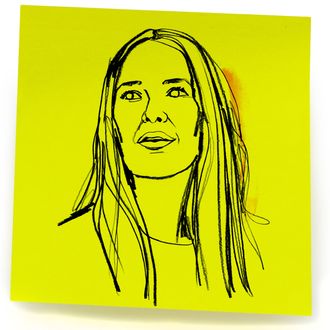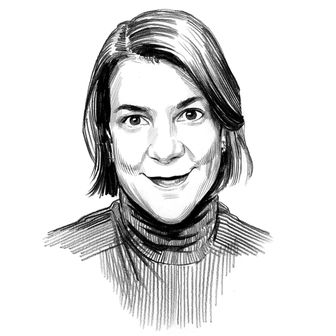
Doing the Most is a special series about ambition — how we define it, harness it, and conquer it.
Ananda Danielle Krettek is the founder and principal of the Google Empathy Lab — the mission of which, as she puts it, is to help Google create technology that works for our “beautifully real, messy human selves.” Before that, she rose through the ranks on the design team at Apple, working under Steve Jobs. On any given day, her current job might involve creating new tools with Google’s artificial intelligence team, talking to Brené Brown about vulnerability, or making a documentary film. (She recently worked with author and guru Ram Dass on new documentary called Becoming Nobody.) She lives in Los Angeles with her dog, Linus. Here’s how she gets it done.
On her morning meditation routine:
There are basically two Danielles. There’s one Danielle who, for periods of time, will get up at 6 a.m., meditate, and then swim or walk or wander. And that’s when I feel like an exemplary human being. Like, I am doing it, yes! And then there’s the other Danielle, which is far more often the case. She gets up about an hour later, and then lies under the thousand-pound duvet contemplating life with the dog, Linus, and being like, Let’s just be lazy and pretend that’s meditation.
For my actual meditation, I do a couple different things. Sometimes I sing, and sometimes I just try to sit in my apartment and get quiet. Or I’ll walk down to the water in L.A. Or sometimes I just stay in bed. There’s that funny thing that happens when you wake up in the morning, where for a brief moment you haven’t remembered who you are yet, at the personality level. And I love that space. What I try to do with my meditation is prolong that state as much as possible. If I have that space of emptiness first thing in the morning, the day is always better. I’m clearer, I have more grace, and the shitty version of me shows up later in the day.
On getting out the door in 15 minutes:
Even though there’s a lot of spaciousness in my morning routine, the actual getting ready for work and sitting down at the office only takes about 30 minutes from the end of my meditation. In terms of getting ready for work, I would love to pretend that it’s like, “I’m so low maintenance and effortless.” But really, I’m lazy. I have long hair because I can just wash it and go. I probably take 15 minutes to get ready — it’s just a quick shower, brush my hair, throw on mascara so that I look awake. And then I grab my dog, grab my laptop and my bag, and head out the door.
On inventing her own job:
I did a lot of work for Nike when I was at the advertising agency Wieden+Kennedy, and that work eventually brought me to Apple, where I was for a very long time, under Steve Jobs during a real golden era of products. When Google brought me on, they actually didn’t have a specific position for me because I was this oddly shaped thing. They were like, “Well, let’s let you find a role that is the shape you are.” I started doing a lot of work for Creative Lab, and then I was at Google X for a while, where I started to chew on questions about the role of technology in our lives. And I started to build a framework for that, and the empathy lab grew out of it.
On managing stress at her job:
My job is still work. Google is still an office, and it’s still a corporation, and we still have to do the hard thing and the boring thing and make tough decisions. What gets me through the hard and sticky stuff is feeling like what I’m doing might actually help somebody. And not help with the big “H” — I mean help with things that make a person’s morning suck a little less because one thing went really smoothly.
On being immersed in work:
I went to Colorado College, where you study one thing really immersively for about three weeks and then take a five-day break. And that rhythm has stuck with me. I like to be deeply, intensively into something, to the degree where I’m dreaming about it at night — eating, sleeping, and breathing it — for defined stints of time. It’s like I have different modes. If I’m in a research phase, I will be in very particular patterns, working kind of like Claire Danes in Homeland, stringing colorful paper on the wall, trying to figure stuff out. If I’m in film mode, I’m working with editing and looking at narratives that come forward. And when we’re in product design, there’s a lot of teamwork, a lot of meetings, a lot of whiteboarding. So whatever I’m serving at the moment, I kind of shape-shift.
On how having a concussion taught her to prioritize:
I had a concussion four years ago, and it taught me how to filter. For a little while afterwards, I would go to the grocery story and be like, Oh my God. 42 types of tomatoes. I can’t deal. Or I’d look at my device and I’d immediately feel tired. I became very aware of my cognitive, emotional, and intentional load, and I still am. I hadn’t been attuned to it before that because I didn’t need to be. Now, I’m able to notice when things feed me or drain me at a very subtle level. When I was younger, I used to be like, Oh, I should read this article because it’s an important thing that smart people are reading. And now I’m like, If I don’t feel it, it’s okay. There are plenty of other smart, thinking people that are going to do that instead. I allow myself to be interested in what I’m interested in. Sometimes it’s a documentary and sometimes it’s a Pixar film. And sometimes it’s trash television and US Weekly.
On dealing with her in-box:
In terms of my aesthetic vibe, I’m an in-box-zero person — I’m into Bauhaus, minimalist design — but I would be a crazy person if I tried to do that in reality. My practice with email is to not let it become the octopus that sucks out my brain and my will to be, because I hate it. It’s so overwhelming. To manage the sheer weight of it, I label all the emails that come in with different colors. Things that are stressful to me, I put soothing colors on. Things that are exciting to me, I put hot colors on. So when I look at my email and see the gradient of emotion, I can recognize the feeling of my in-box without even having to read anything. That helps me be like, Well, I can handle this hot stuff right now. Or, Well, that’s shit I don’t want to do. I’ll handle that when I have a little bit more time.
On dealing with anxiety:
If I’m really stuck in my own mind and trying to process whatever I’m neurotically obsessing about, it helps to get in the ocean. There’s something about being in the water that washes me clean of all of my human bullshit. It’s a reset button for me. That’s my cheat. But if I’m not in a place where I can do that, like if I’m in New York, I go for a walk and try to tune into the rhythm around me, just to get outside of myself. In moments when I’m stewing, it helps to tune into something else, which will usually carry me out of it.
And then there’s my dog, Linus. He’s a magical healing creature. I rescued him here in L.A. 13 years ago, and he’s now 14. He basically looks like a black-lab puppy, but he’s got these Farrah Fawcett fringe ears. I think he’s a beagle-cocker mix or lab-cocker mix. He is a wise soul.
On what motivates her:
I don’t identify as ambitious at all. Instead, I feel like I’m this twirl of energy, and there’s a creative force that comes through me. The creative process can feel like a super-neurotic shit show on a bad day. And it can feel like this beautiful, elegant, effortless, forming flow on a good day. The thing that really makes my heart beat is when someone tells me an intimate secret about themselves. People tend to do that with me. That’s a sacred, precious thing.
More From This Series
- 25 Famous Women on Achieving Success Later in Life
- What the Author of Pachinko and Free Food for Millionaires Wears to Work
- The Good Thing About Confessing Even Giant Screwups


